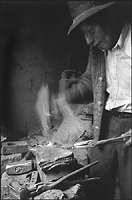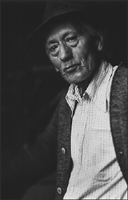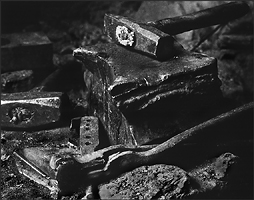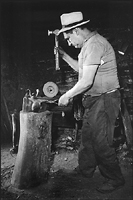



Home Ecuador
While walking through the streets one day, I happened by an open door from which issued the clanging of steel against steel. I looked inside, and the old man who was standing over the anvil looked up and smiled, and invited me in to sit. The shop was small and dark, with a low bench along one wall where he motioned me to rest. Hanging on the wall above the bench were hand-operated wood bits of different bores, and various small farming tools that he’d made. The scarred and nicked anvil stood atop a wooden stump, and hammers and pliers were scattered nearby. The cement forge stood against the wall on the smith’s right side, and a large hand-operated bellows was incorporated into it. At the back of the shop was a pile of charcoal, and every now and then the old man, whose name was Juan, would use a small shovel to add some fresh fuel to the fire. Then he would pump the wooden handle of the bellows until the coals glowed, sending red and yellow sparks climbing the walls to the ceiling and then falling to disappear in the dirt. He took his long-handled pliers and extracted a thin piece of hot steel from the fire, and pressed and shaped it between the anvil and his hammer with swift, ringing strokes. It was the blade of a dagger. He showed me the handle that had been carved from a bull’s horn in a shape to comfortably be held in the hand. The handle had the figure of a dog’s head at one end.
Juan claimed to have been practicing blacksmithing for sixty of his sixty-eight years. His shop adjoined the home where he and his family lived. His grandsons were shoemakers, and his granddaughter worked at embroidery. He took a few moments to show me around his house. We passed through the small courtyard open to the sky, and climbed some steps to a brick porch that had a view through and over the tiled rooftops. Juan pointed out the potted plants that stood on the bricks against the wall, noting in particular a bushy basil plant. From this he broke several branches and gave them to me as a parting gift.
When I returned to see Juan several weeks later, he showed me the completed dog-handled knife. The hammer marks still could be seen on the sharpened blade, and the bone of the handle had been lacquered a dark green. He’d made a metal-tipped sheath of leather to contain the knife and tooled some designs lightly on its surface. The dagger was somewhat crudely finished, but the old smith laid claim to its durability, and his life was the testimony.
There was another blacksmith in town who did pretty much the same type of work as Juan. This smith indicated to me the huge bellows that powered his forge, and claimed that it was over 100 years old. He and his assistant were busy working on the tip of a farming tool. When the steel was heated, the smith held it on the anvil with his pliers in one hand, and a small hammer in the other. The assistant stood on the other side with a much larger hammer, and they alternated strokes until the steel was too cool to be shaped. Then the assistant, a tall man, returned the piece to the forge, and the old bellows once again gave its breath to force fire from the coals. The light from a couple of doorways did little to brighten the blackened interior of the shop. Stacks of steel were scattered about, and a heap of charcoal lay against one wall.
While in this shop, I witnessed a rare example of openly rude behavior directed towards those whom many considered to be a lower class. A group of Indians came by with an old knife which needed a new handle. The owner of the shop pulled out several knives and machetes from behind a box along one wall and displayed his work, the handles in particular. They were all cast steel, and all in the shape of a dog’s head. While the business was being transacted, the assistant was sifting the coals in the forge with a small, long-handled shovel. He was tossing the cinders on the floor, and managing to get a few on the shoes of a woman in the group. Just as they were leaving, he tossed a shovelful on the edge of her red skirt, a small symbol of his esteem. She paid no attention. Although the Indians are obviously in an inferior social position, this was the only time I’d seen such an obvious insult.